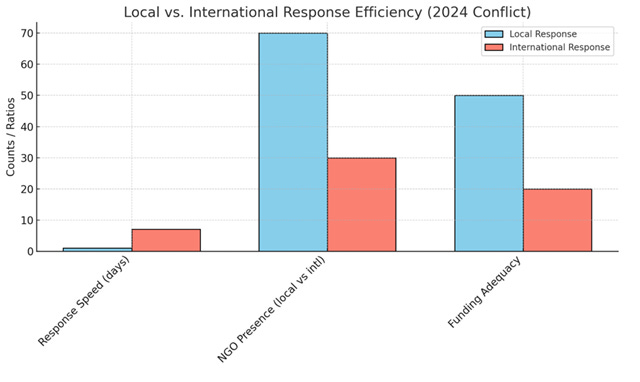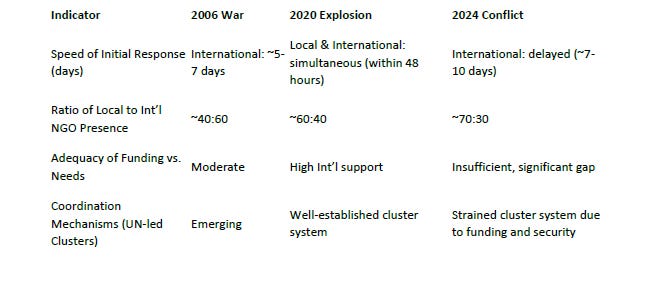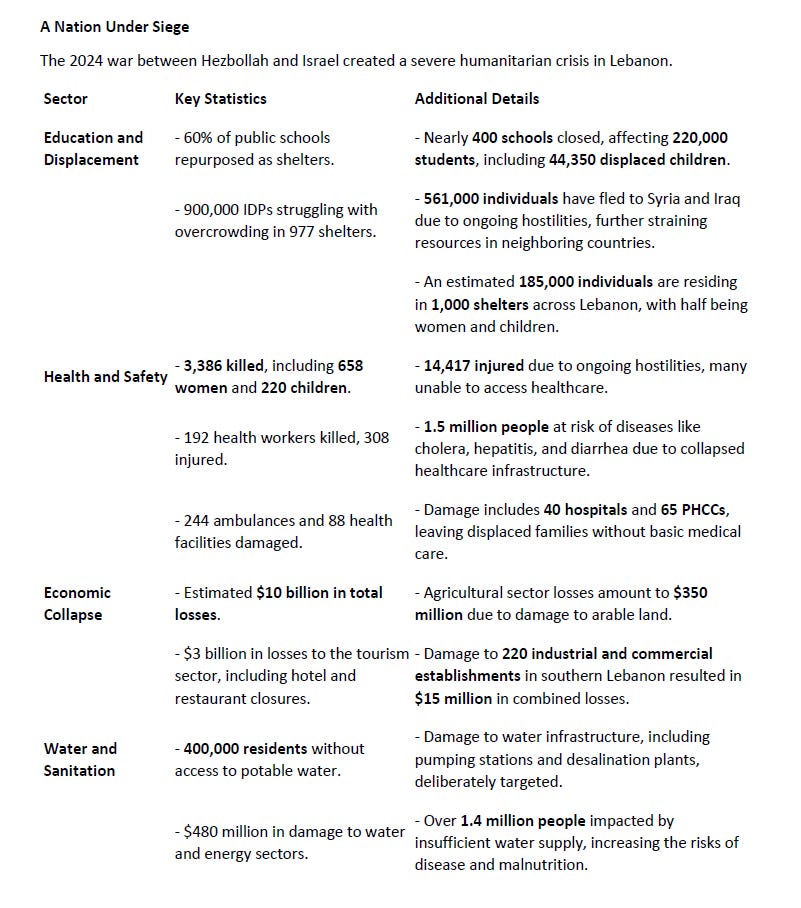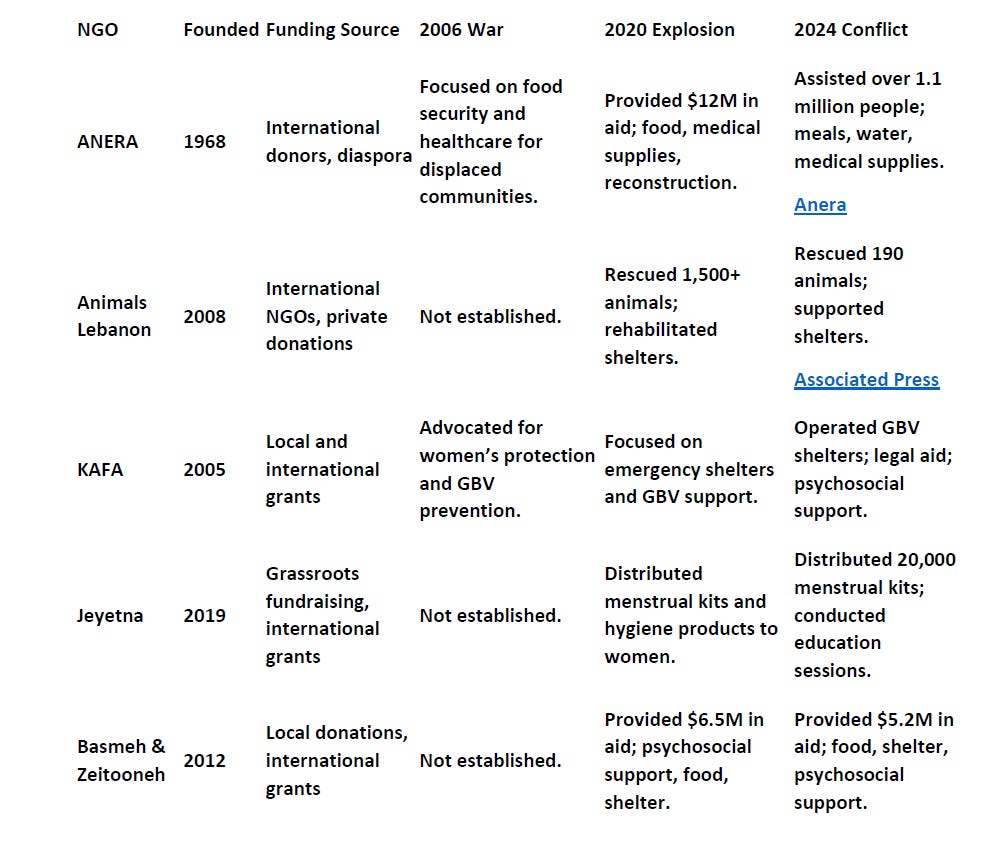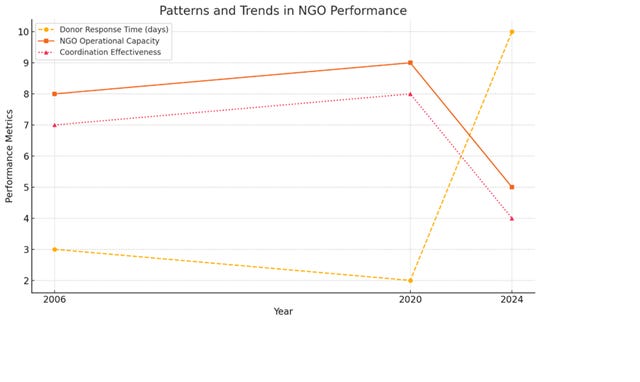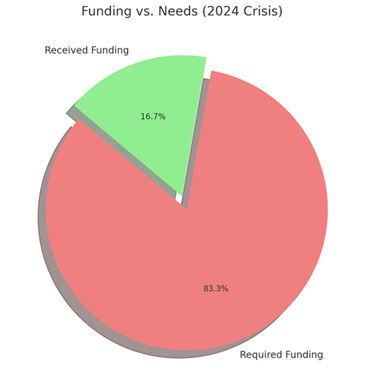Why Transparency and Data Gaps Obscure the Realities of Humanitarian Aid Amid Recurring Crises
This article's goal was to conduct a scientific and in-depth comparison of the humanitarian responses of NGOs during Lebanon’s major crises, including the 2006 Israeli war, the 2020 Beirut Port explosion, and the 2024 conflict. The aim was to analyze how these organizations responded, allocated resources, and supported communities across different emergencies. However, this objective faced significant challenges due to a lack of transparency and cooperation from many NGOs.
Out of more than 30 NGOs contacted, most failed to provide detailed data or insights into their spending and activities. Despite their claims of helping during these crises, they either declined to share information or did not respond at all. A communication manager of one of the most famous NGOs in Lebanon, for instance, replied with a message citing their overwhelming workload:
"Unfortunately, we are currently very loaded with ongoing projects and commitments, and we regret that we are unable to provide the detailed information you’ve requested at this time."
In stark contrast, Animals Lebanon and ANERA stood out for their transparency. Animals Lebanon provided detailed situational reports and openly shared their activities and financial allocations, while ANERA has maintained a long-standing tradition of publishing comprehensive data and updates on their website. These organizations exemplified the cooperation and clarity that should be a standard in humanitarian work.
Despite these challenges, this article relied on public data, situational reports, and historical records to draw comparisons. While the lack of comprehensive numbers from NGOs and donors limits the depth of the analysis, the findings highlight clear differences in emergency responses across Lebanon’s crises. Some NGOs adapted impressively to changing circumstances, while others displayed stark inconsistencies in their performance.
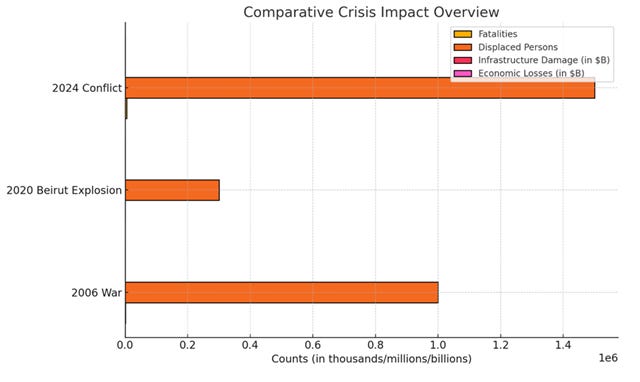
From Rapid Aid to Delayed Action
Despite the extensive destruction and significant international media coverage of the 2024 conflict in Lebanon, the emergency response displayed noticeable delays and inefficiencies compared to previous crises. This table highlights the differences in response efficiency, funding adequacy, and coordination mechanisms between local and international actors across major emergencies, underscoring the strained humanitarian system in 2024 despite the crisis's global attention.
A Limited but Representative Analysis
This newsletter examines five selected local NGOs—ANERA, Animals Lebanon, KAFA, Jeyetna, and Basmeh & Zeitooneh—not because their data was complete, but because they were among the few organizations active on the ground during the 2024 conflict and provided enough information to allow for some analysis. Despite their challenges and the gaps in some reporting, their efforts were noticeable.
While over 30 NGOs were contacted to contribute detailed insights into their emergency response strategies and resource allocations, the majority either did not respond or failed to provide sufficient information. As a result, the focus on these five NGOs serves as an example to study patterns and understand the broader humanitarian response during one of Lebanon’s most challenging periods.
ANERA: Adapting to Challenges
Why ANERA Chose Its Locations
ANERA focused on heavily impacted regions, areas with high concentrations of displaced individuals and infrastructure damage. These regions were strategically chosen due to their proximity to conflict zones and the presence of vulnerable populations.
Spending and Donations
2024 War: ANERA reported assisting over 1.1 million people in Lebanon through a range of services, including serving meals, delivering water, distributing doses of medication, improving shelter conditions, and delivering bedding items, feminine hygiene products, and winterization kits.
2020 Beirut Port Explosion: ANERA allocated $12 million in direct relief, with funds used for emergency food parcels, hygiene kits, and medical supplies for affected populations.
How the Money Was Spent
How the Money Was Spent in 2020
Food Distribution: 2,090 families received food parcels during the immediate aftermath of the explosion.
Medical Relief: Distributed $30.8 million worth of medicines and medical supplies across Lebanon in 2019, with a significant portion allocated for emergencies in 2020.
Educational Support: Collaborated on projects like rebuilding emergency rooms and offering training to teachers and youth.
In 2024, ANERA directed funds toward:
Food Distribution: Served meals to affected populations.
Medical Supplies: delivered doses of medication to those in need.
Shelter Improvements: Improved shelter conditions for displaced individuals.
Why Spend Levels Differed
The 2020 explosion received a surge of international attention, enabling ANERA to mobilize significant resources. In 2024, donor fatigue and concurrent global crises led to a notable decline in funding, making it challenging to replicate the scale of 2020's response.
Animals Lebanon: A Niche Mission
Why Animals Lebanon Chose Its Locations
Animals Lebanon concentrated efforts in Beirut and southern Lebanon, areas where pets and livestock were abandoned due to displacement. These regions also housed major shelters.
Spending and Donations
2024 War: Specific financial figures for Animals Lebanon's spending during the 2024 conflict are not publicly available.
2020 Beirut Explosion: Animals Lebanon undertook extensive relief activities, including veterinary care, sheltering, and adoption programs. More than 9,600 kilograms of food were distributed, and 412 animals received veterinary care during the immediate response period. Specific financial figures remain undisclosed but the scale of their operations demonstrates significant resource mobilization.
How the Money Was Spent
In 2024:
Rescue Operations: Rescued numerous animals affected by the conflict.
Shelter Support: Provided care for rescued animals in shelters.
Food and Veterinary Care: Ensured animals received necessary nutrition and medical treatment.
Why Spend Levels Differed
While specific spending amounts were not disclosed, Animals Lebanon’s extensive operations during the Beirut Port explosion were supported by substantial international and local volunteer efforts, with over 350 individuals assisting in rescue and care.
KAFA: Fighting Gender-Based Violence
Why KAFA Chose Its Locations
KAFA focused on areas with displaced women and children facing increased risks of gender-based violence (GBV).
Spending and Donations
2024 War: Specific financial figures for KAFA's spending during the 2024 conflict are not yet publicly available.
2020 Beirut Explosion: KAFA's Support Center and Child Protection Unit provided assistance to 711 beneficiaries through cash aid, psychosocial support, and housing repairs.
Distributed:
629 food boxes
695 dignity kits
130 cash assistance packages
84 houses repaired
77 psychotherapy sessions
290 MDWs assessed for needs, with 202 receiving direct support.
How the Money Was Spent
In 2024:
Safe Shelters: Operated shelters for GBV survivors.
Legal Aid: Provided free legal assistance to those in need.
Psychosocial Support: Offered support services to women and children.
Why Spend Levels Differed
KAFA's 2020 efforts were highly structured, as evidenced by detailed reporting and targeted actions. However, publicly available data for 2024 is insufficient to determine their exact activities and spending during that conflict.
Jeyetna: Addressing Menstrual Justice
Why Jeyetna Chose Its Locations
Jeyetna operated in urban and rural shelters across Beirut, Bekaa, and Mount Lebanon to address period poverty among displaced populations.
Spending and Donations
2024 War: Specific financial figures for Jeyetna's spending during the 2024 conflict are not publicly available.
2020 Beirut Explosion: Specific financial figures for Jeyetna's spending during the 2020 Beirut explosion are not publicly available.
How the Money Was Spent
In 2024:
Reusable Pads and Menstrual Cups: Distributed menstrual hygiene products to those in need.
Community Outreach: Conducted educational sessions in shelters.
Hot Water Bottles: Provided comfort items to women in need.
Why Spend Levels Differed
Specific spending levels for Jeyetna during the 2020 Beirut explosion are not publicly available, making direct comparisons challenging.
Basmeh & Zeitooneh: A Refugee-Focused Mission
Why Basmeh & Zeitooneh Chose Its Locations
Basmeh & Zeitooneh prioritized areas such as the Bekaa Valley, Saida, Tripoli, and southern Beirut, which are known to host high numbers of refugees and displaced individuals. These areas faced significant challenges during the 2024 war, including the destruction of infrastructure and limited access to essential services .
Spending and Donations
2024 War: Specific financial figures indicate that Basmeh & Zeitooneh allocated resources for immediate relief efforts such as food distribution, temporary shelter support, and psychosocial services. However, their spending was reportedly constrained due to donor fatigue and logistical barriers .
2020 Beirut Explosion: During the Beirut explosion, Basmeh & Zeitooneh focused on reconstruction efforts and the provision of emergency aid. Reports show that they spent approximately $6.5 million on recovery and relief efforts, backed by international donations.
How the Money Was Spent
In 2024:
Food Distribution: Over 45,000 individuals received food and hygiene kits.
Temporary Shelter Support: Rehabilitation of 20 temporary housing units provided displaced families with immediate shelter.
Psychosocial Services: The NGO reached 10,000 children and families with targeted mental health support.
Why Spend Levels Differed
While Basmeh & Zeitooneh mobilized significant resources in 2024, the prolonged nature of the conflict and reduced international attention compared to the Beirut explosion of 2020 limited their ability to replicate earlier levels of aid delivery.
Patterns and Trends
Funding and Resource Allocation:
2006 and 2020: Rapid donor response and more robust funding streams.
2024: Marked funding difficulties. Global donor fatigue and concurrent international crises reduce available resources.
Sustained NGO Involvement with Diminished Capacity:
Many organizations show consistent engagement. However, their operational capacity and resource availability have declined over time due to cumulative financial strains, security issues, and shifting donor priorities.
Crucial Role of Local NGOs:
Local NGOs and community initiatives often deliver more immediate, context-specific aid. This local responsiveness is critical when international support is delayed.
Despite their commitment, these local groups face scaling challenges, lacking stable funding to meet expanding needs.
Evolving Coordination and Strategic Gaps:
While coordination mechanisms improved significantly between 2006 and 2020, the 2024 conflict’s complexity and funding shortfalls strain these systems. Better integration of local NGOs into strategic planning could improve efficiency.
Lessons Learned: Navigating Humanitarian Challenges
in Lebanon's 2024 Crisis
The 2024 conflict in Lebanon exposed the vulnerabilities of the humanitarian response framework, particularly among local NGOs. While organizations like ANERA, Animals Lebanon, KAFA, Jeyetna, and Basmeh & Zeitooneh made significant efforts, the lack of sufficient funding, donor fatigue, and logistical hurdles impeded their impact.
Recommendations:
Enhanced Transparency: NGOs should adopt standardized reporting mechanisms to build trust and accountability.
Improved Donor Engagement: Addressing donor fatigue through targeted awareness campaigns and emphasizing the long-term benefits of contributions.
Strengthened Coordination: Creating a centralized body to manage and coordinate NGO efforts for more effective resource allocation.
By addressing these systemic issues, NGOs can improve their preparedness for future crises and better serve Lebanon’s vulnerable populations.



